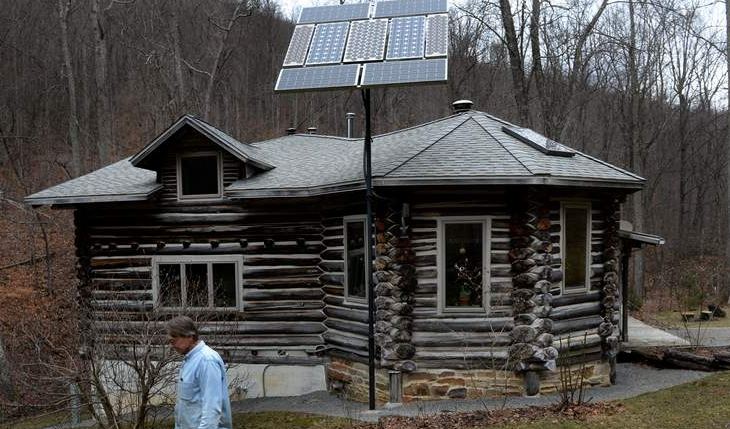What we love is the progression of this couple’s nature home. They learned as they moved along. They’ve faced bears, built a home from scratch, used propane and solar for a while before discovering the wonderful world of hydropower! They are paragons of survival!
But from a deck overlooking the creek that flows behind and below the house, Janowski found the inspiration for a new project that would reduce the home’s reliance on propane, eliminate the need to run a gasoline generator when weather made solar energy production dicey, and maybe harness enough new energy to power larger appliances, like a freezer.
“I had looked at all that power flowing by for years,” he said.
During that time, improvements in design and technology were making small-scale hydroelectric production more efficient and affordable. In 2012, Janowski decided it was time to build a micro-hydro system of his own.
The Webster County man started the process by clearing a straight as possible channel for the penstock — the pipe carrying water from an intake point to a turbine — through the rocks and rhododendron roots lining the creek from a weir site just below his home to the place where his miniature powerhouse would be built. A concrete saw with a diamond-tipped blade was used to cut through rocks to accommodate the 4-inch-diameter, 515-foot long PVC penstock, which drops 47 feet in elevation from intake to outflow.
Janowski built a concrete weir that blends with a stream-wide flat rock, and channels water into an aluminum intake box he designed and built, which is topped with a debris-shedding screen fabricated by Conn-Weld Industries of Princeton. In the powerhouse at the lower end of the penstock, water enters a Stream Engine turbine built by Energy Systems and Design, using a manifold Janowski designed and built.
The couple’s micro-hydro power plant went online on Oct. 29, 2012, the day Hurricane Sandy hit West Virginia, dumping massive amounts of snow across the state, causing widespread power outages. The Janowskis, however, had power to spare, thanks to their backyard hydro-power operation.
“It works on the same principle as the Hoover Dam, but it can be done small-scale very easily,” Janowski said. “Technology has come a long way with this stuff. There’s all kinds of information out there now, and you can even buy pre-built systems that you can just plug in and start using.”
The Janowskis had certified electrician and solar power expert Matthew Sherald of PIMBY (Power In My Back Yard) Energy of Thomas check out their system before flipping the “on” switch. “I would recommend that anyone who builds a micro-hydro system have a certified electrician take a look at it before operating it,” he said.
Janowski said his system, which he describes as overbuilt, cost about $12,000. “It could be done for half that,” he said.
With the addition of the micro-hydro system — which provides about 90 percent of their electricity, while the solar array accounts for the rest during periods of exceptionally low flow — “we have more power than we can use,” Janowski said, even with the addition of a freezer, washer, dryer and microwave oven. The gas generator the couple once ran about 10 hours a week during winter is no longer needed.
“Once the system’s hooked up, it’s pretty much hands-free and really easy to operate,” Janowski said. “Water power is such a great natural resource here in the West Virginia mountains, where there are hundreds of creeks like this. It’s a resource that’s been overlooked, but it can be done on this scale very easily.”
For some people, this way of life comes naturally. We love the idea of how rustic their life was before hydropower and how now, even though they are still in their cabin in the woods, they have more power than what they need. They even have a washer and dryer!
They were doing well even during Hurricane Sandy. While others were fighting for survival they were thriving! That tells you all about doing a job and doing it well!
Read more about this twosome and their off the grid living style in the Charleston Gazette Mail.
